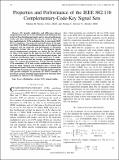| dc.contributor.author | Royster, Thomas C., IV | |
| dc.contributor.author | Pursley, Michael B. | |
| dc.date.accessioned | 2010-12-08T20:52:34Z | |
| dc.date.available | 2010-12-08T20:52:34Z | |
| dc.date.issued | 2009-02 | |
| dc.date.submitted | 2009-02 | |
| dc.identifier.issn | 0090-6778 | |
| dc.identifier.other | INSPEC Accession Number: 10475375 | |
| dc.identifier.uri | http://hdl.handle.net/1721.1/60242 | |
| dc.description.abstract | We describe similarities and differences between complementary-code-key (CCK) modulation and modulation that is derived from biorthogonal signals, and we present performance results and other information that may be useful to those who have applications for CCK modulation that do not require IEEE 802.11 b compliance. The properties and performance of the highrate IEEE CCK 802.11 b modulation formats are investigated and compared with the properties and performance of alternative modulation formats that are based on biorthogonal signals. Several complementary properties are derived for the full-rate (11 Mb/s) CCK signal set, the half-rate (5.5 Mb/s) CCK signal set, a full-rate signal set obtained from biorthogonal signals, and a half-rate biorthogonal signal set. Each signal set is a complementary set, but each also has stronger complementary properties. We evaluate the performance of IEEE 802.11 b standard CCK modulation, CCK with certain modifications that depart from the IEEE standard, and modulation that is derived from biorthogonal signals. Performance comparisons are presented for additive white Gaussian noise (AWGN) channels and for channels with specular multipath. In particular, for AWGN channels, we provide an accurate analytical approximation for the frame error probability for full-rate CCK modulation. | en_US |
| dc.description.sponsorship | United States. Office of Naval Research (N00014-04-1-0563) | en_US |
| dc.description.sponsorship | National Science Foundation (U.S.) (Graduate Research Fellowship) | en_US |
| dc.language.iso | en_US | |
| dc.publisher | Institute of Electrical and Electronics Engineers | en_US |
| dc.relation.isversionof | http://dx.doi.org/10.1109/TCOMM.2009.02.060642 | en_US |
| dc.rights | Article is made available in accordance with the publisher's policy and may be subject to US copyright law. Please refer to the publisher's site for terms of use. | en_US |
| dc.source | IEEE | en_US |
| dc.title | Properties and performance of the IEEE 802.11b complementary-code-key signal sets | en_US |
| dc.type | Article | en_US |
| dc.identifier.citation | Pursley, M., and T. Royster Iv. “Properties and performance of the IEEE 802.11b complementary-code-key signal sets.” Communications, IEEE Transactions on 57.2 (2009): 440-449. ©2009 IEEE. | en_US |
| dc.contributor.department | Lincoln Laboratory | en_US |
| dc.contributor.approver | Royster, Thomas C., IV | |
| dc.contributor.mitauthor | Royster, Thomas C., IV | |
| dc.relation.journal | IEEE Transactions on Communications | en_US |
| dc.eprint.version | Final published version | en_US |
| dc.type.uri | http://purl.org/eprint/type/JournalArticle | en_US |
| eprint.status | http://purl.org/eprint/status/PeerReviewed | en_US |
| dspace.orderedauthors | Pursley, Michael; Royster Iv, Thomas | en |
| mit.license | PUBLISHER_POLICY | en_US |
| mit.metadata.status | Complete | |
